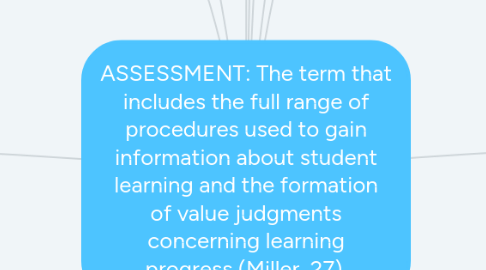
1. Identify goals in the classroom
1.1. Pre-assess your students needs
1.2. Instruct your students
1.3. Assess students to determine if learning objectives were achieved
1.4. Utilize the data gathered from the assessment
2. Test: A specific type of assessment (Miller, 27).
2.1. Measurement: The assigning of numbers to the results of a test according to a specific rule.
3. Typical Performance (Miller, 34-35)
3.1. Designed to reflect a person's typical behavior.
3.1.1. What an students will do.
3.1.1.1. Interests, attitudes, adjustment, and personality traits are assessed.
3.2. Nature of Assessment
4. Complex Performance Assessment (Miller, 36)
4.1. Reflects long-term instructional goals.
4.1.1. Requires students to solve problems of importance or perform in valued ways.
4.2. Lengthier test process.
4.2.1. Humans have to correct the tests.
4.3. Essays, opened-ended math problems, lab experiments, oral presentations, artwork, etc.
4.4. Form of Assessment
5. Formative (Miller, 36-38)
5.1. Monitors learning progress throughout instruction.
5.1.1. Not linked to a particular test because it is part of the learning and teaching process.
5.2. Can lead to changes in learning.
5.2.1. Provides continuous feedback for both students and teachers.
5.3. Teacher-made tests for each segment of instruction, classroom observations, pop-quizzes, homework assignments, etc.
5.4. Use in Classroom Instruction
6. Summative (Miller, 36-38)
6.1. Assesses achievement after completion of instruction.
6.1.1. Grading or certification of student achievement.
6.2. Have the instructional goals and course objectives been achieved?
6.2.1. Was the instruction overall effective?
6.3. Teacher-made achievement tests, ratings on performances such as labs or oral reports, assessment products such as drawings or reports, etc.
6.4. Use in Classroom Instruction
7. Norm Referenced (Miller, 39-41)
7.1. Assessment designed to provide a measure of performance based on a students standing in a known group.
7.1.1. How their performance was compared to others in the class.
7.2. Norms are determined by local, state, or national groups.
7.2.1. Percentile Score
7.3. Covers a large domain of learning tasks.
7.3.1. Emphasizes discrimination among students in terms of relative level of learning.
7.3.1.1. Favors items of average difficulty.
7.3.1.1.1. Interpretation requires a clearly defined group.
7.4. Method of Interpreting Results
8. What is being assessed?
8.1. What is the assessment procedure based on?
8.2. What are the variety of procedures that you will use?
8.3. Are you aware of the assessments limitations?
8.4. How will you utilize the data that you obtain from the assessment?
9. Maximum Performance (Miller, 34-35)
9.1. Determines a students developed abilities or achievements.
9.1.1. Students put forth best effort, what students can do.
9.1.1.1. Aptitude and achievement tests
9.2. Nature of Assessment
10. Fixed Choice Test (Miller, 36)
10.1. Students can respond to a large number of questions in a brief amount of time.
10.1.1. Tests are corrected by machine.
10.2. Overemphasis on factual knowledge.
10.2.1. Doesn't test high-order, problem-solving, and conceptual skills.
10.3. Multiple choice, True or False, Matching, etc.
10.4. Form of Assessment
11. Placement (Miller, 36-38)
11.1. Determines performance prior to the start of instruction.
11.1.1. Determines what instruction will benefit them the most.
11.2. Does the student possess the knowledge and skills needed?
11.2.1. Does the student have background knowledge that will help them?
11.3. Pretests, records of past achievement, observational techniques, ability tests, etc.
11.4. Use in Classroom Instruction
12. Diagnostic (Miller, 36-38)
12.1. Diagnoses learning difficulties throughout instruction
12.1.1. Usually occurs after formative assessment fails on multiple occasions.
12.2. More comprehensive and detailed.
12.2.1. Requires educational, psychological, and medical specialists with an IEP developed.
12.3. Determine causes of learning problems and formulate a plan at assist student.
12.4. Use in Classroom Instruction
13. Criterion Referenced (Miller, 39-41)
13.1. Assessment designed to provide a measure of performance based on a clearly defined domain of learning tasks.
13.1.1. How their performance was just for that student alone.
13.2. Describes a specific learning task a student can perform, percentage of tasks a student performs correctly, student performance at a certain level based on the set performance standard.
13.2.1. Percentage-Correct Score
13.3. Covers a limited domain of learning tasks.
13.3.1. Emphasizes description of what learning tasks can and cannot perform.
13.3.1.1. Matches item difficulty to learning tasks.
13.3.1.1.1. Interpretation requires a clearly defined and limited achievement domain.

